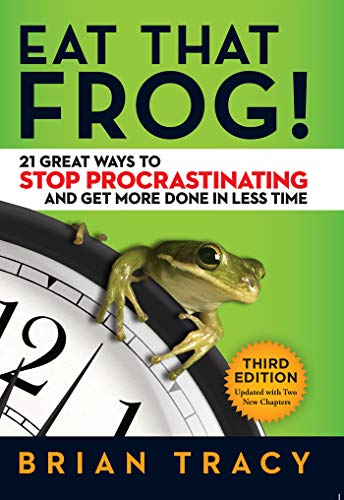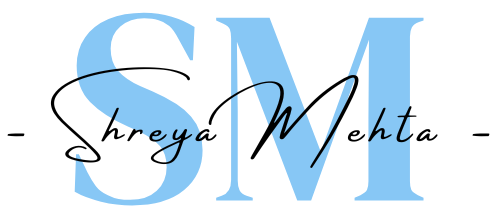
Eat That Frog – Brian Tracy
The Book in Three Sentences
- Your ‘frog’ is your biggest, most important task
- If you have two frogs, eat the ‘ugliest’ one first
- If you have to eat a frog, don’t procrastinate on it
The Five Big Ideas
- “The key to reaching high levels of performance and productivity is to develop the lifelong habit of tackling your major task first thing each morning.”
- “Think about your goals and review them daily. Every morning when you begin, take action on the most important task you can accomplish to achieve your most important goal at the moment.”
- “Think on paper.”
- “Always work from a list.”
- “Your ability to choose between the important and the unimportant is the key determinant of your success in life and work.”
The key to success is not to try to do everything, but to focus fully on the most vital tasks, take action, and complete them well. The analogy of eating frogs comes from Mark Twain, who says that if you can start your morning by eating a live frog, you’d have tackled the worst thing that can happen that day. Your frog is your most crucial task—what you’re most likely to defer, yet can create the biggest impact on your outcomes.
To form any new habit (including the habit of eating frogs), you need the 3Ds of New Habit Formation: Make a decision to build the habit of completing tasks, have the discipline to keep applying the ideas in this book, and have the determination to persevere until the habits become an integral part of who you are.
- Set the Table : “Think about your goals and review them daily. Every morning when you begin, take action on the most important task you can accomplish to achieve your most important goal at the moment.”
- Plan Each Day in Advance: “Make your list the night before for the workday ahead.”
- Apply the 80/20 Rule to Everything : Before you begin work, always ask yourself, ‘Is this task in the top 20 percent of my activities or in the bottom 80 percent?’ “Your ability to choose between the important and the unimportant is the key determinant of your success in life and work.”
- Consider the Consequences: In your work, having a clear idea of what is really important to you in the long term makes it much easier for you to make better decisions about your priorities in the short term. Thinking continually about the potential consequences of your choices, decisions, and behaviors is one of the very best ways to determine your true priorities in your work and personal life.
- Apply Creative Procrastination: “The difference between high performers and low performers is largely determined by what they choose to procrastinate on.” “Look at your work activities and identify the tasks that you could delegate or eliminate to free up more time for the work that really counts.”
- Use the ABCDE Method: “An ‘A’ item is defined as something that is very important, something that you must do. “A ‘B’ item is defined as a task that you should do.” “A ‘C’ task is defined as something that would be nice to do but for which there are no consequences at all, whether you do it or not.” “A ‘D’ task is defined as something you can delegate to someone else.” “An ‘E’ task is defined as something that you can eliminate altogether, and it won’t make any real difference.”
- Focus On Key Result Areas: One of the greatest questions you will ever ask yourself: “What one skill, if I developed and did it in an excellent fashion, would have the greatest positive impact on my career?”
- Apply The Law Of Three: “It is the quality of time at work that counts and the quantity of time at home that matters.”
- Prepare Thoroughly Before You Begin: Get everything you need at hand before you begin. Brian’s personal rule is “Get it 80 percent right and then correct it later.”
- Take It One Step at a Time: Get your mind off the huge task in front of you and focus on a single action that you can take.
- 11. Upgrade Your Key Skills: “Continuous learning is the minimum requirement for success in any field.”
- Leverage Your Special Talents: Continually ask yourself these key questions:“What am I really good at? What do I enjoy the most about my work?”
- Identify Your Key Constraints: Successful people always begin the analysis of constraints by asking the question, “What is it in me that is holding me back?”
- Apply Pressure On Yourself : “To reach your full potential, you must form the habit of putting the pressure on yourself and not waiting for someone else to come along and do it for you.”
- Maximize Your Personal Powers : “Whenever you feel overtired and overwhelmed with too much to do and too little time, stop yourself and just say, ‘All I can do is all I can do.’”
- Motivate Yourself Into Action: Optimism is the most important quality you can develop for personal and professional success and happiness.
- Stop Technological Time Drain : “For you to stay calm, clear headed, and capable of performing at your best, you need to detach on a regular basis from the technology and communication devices that can overwhelm you if you are not careful.”
- Slice And Dice The Task: Cut a big task down to size using the “salami slice” method of getting work done.
- Create Large Chunks Of Time : “Your ability to carve out and use these blocks of high-value, highly productive time is central to your ability to make a significant contribution to your work and to your life.”
- Develop A Sense Of Urgency: “When you regularly take continuous action toward your most important goals, you activate the Momentum Principle of success. This principle says that although it may take tremendous amounts of energy to overcome inertia and get started initially, it then takes far less energy to keep going.”
- Single-Handle Every Task: “Your ability to select your most important task, to begin it, and then to concentrate on it single-mindedly until it is complete is the key to high levels of performance and personal productivity.”
Eat That Frog! Summary
- “Your ‘frog’ is your biggest, most important task, the one you are most likely to procrastinate on if you don’t do something about it.”
- “The first rule of frog eating is this: If you have to eat two frogs, eat the ugliest one first.”
- “Continually remind yourself that one of the most important decisions you make each day is what you will do immediately and what you will do later if you do it at all.”
- “The second rule of frog eating is this: If you have to eat a live frog at all, it doesn’t pay to sit and look at it for very long.”
- “The key to reaching high levels of performance and productivity is to develop the lifelong habit of tackling your major task first thing each morning.”

